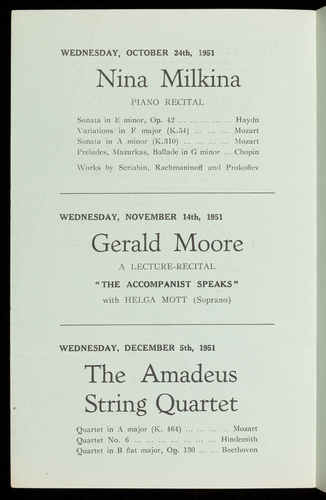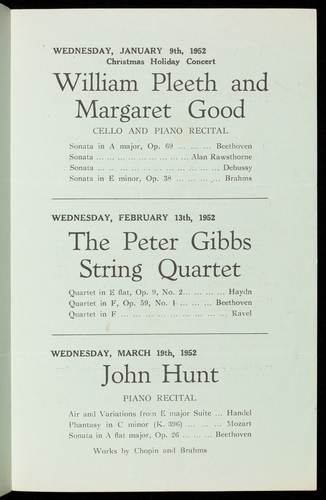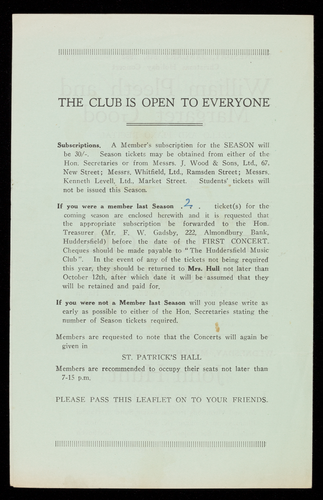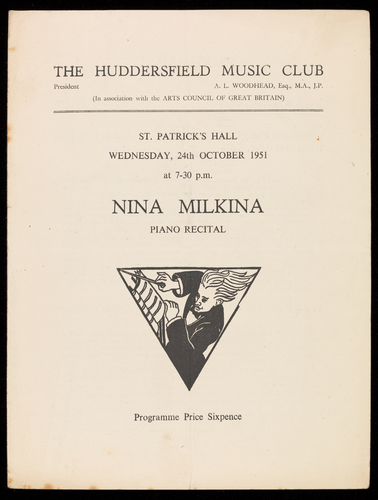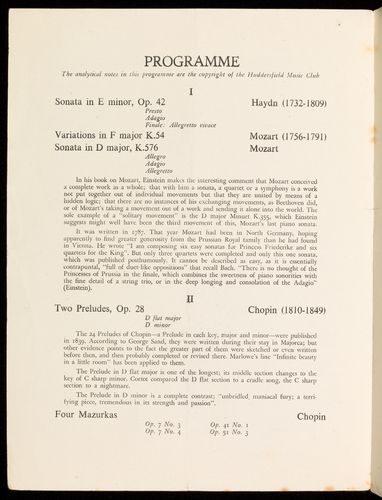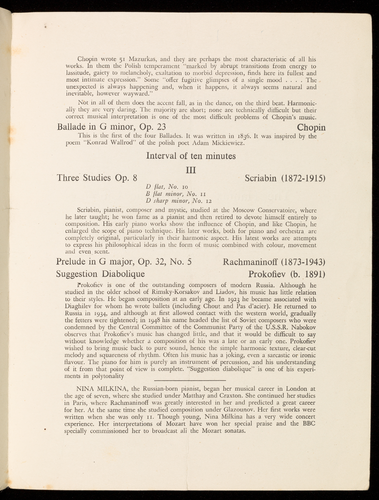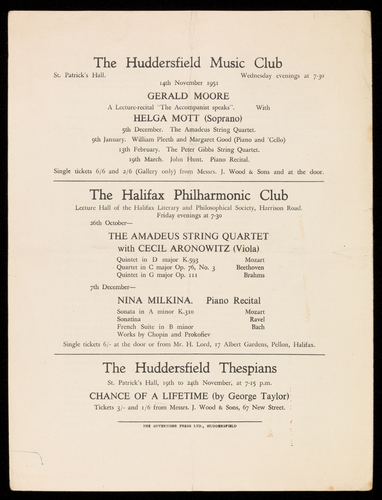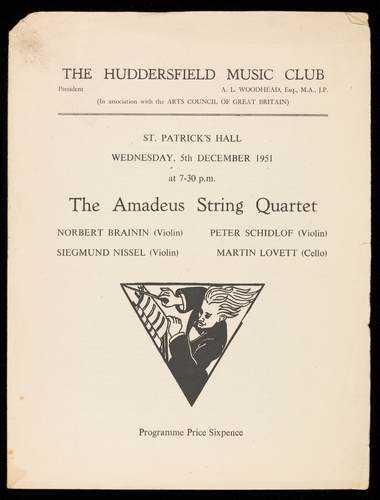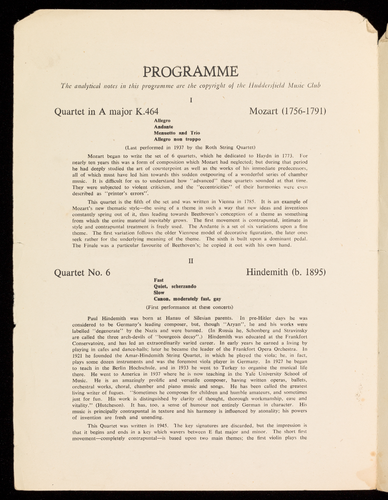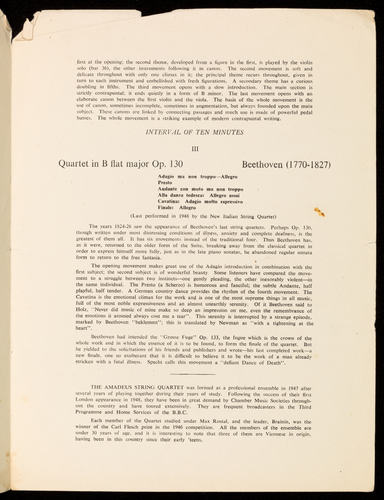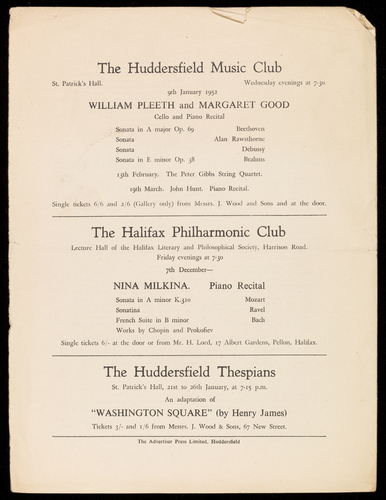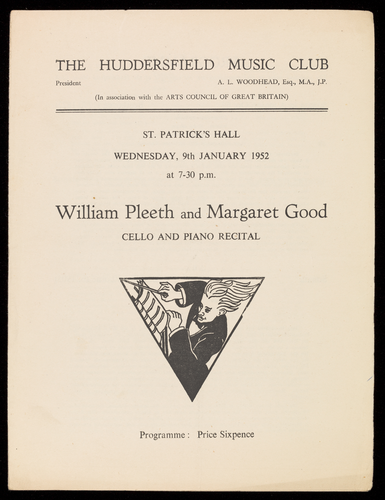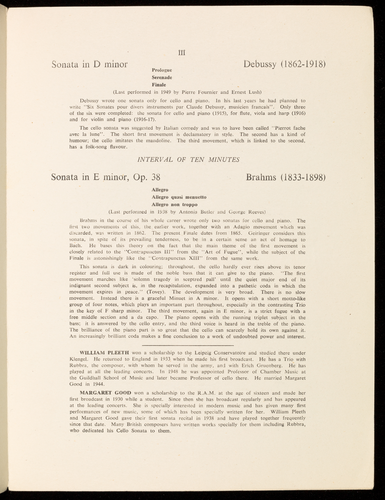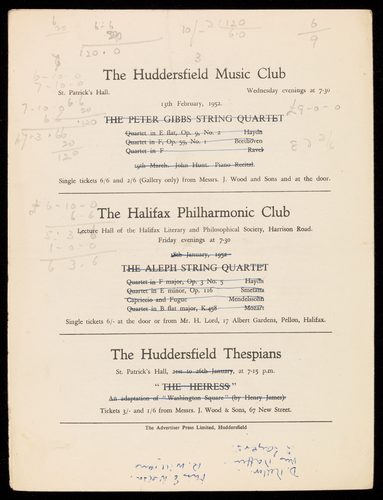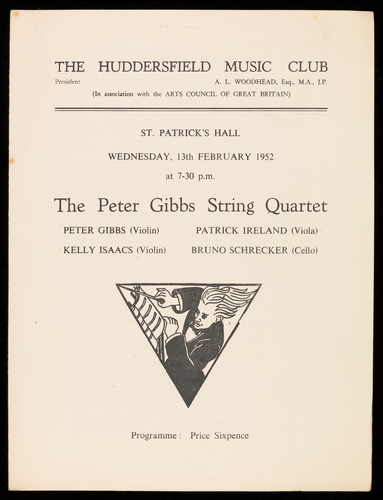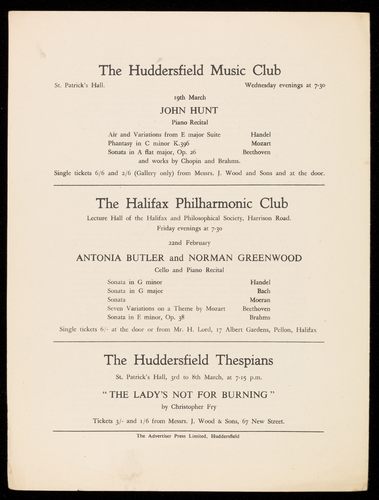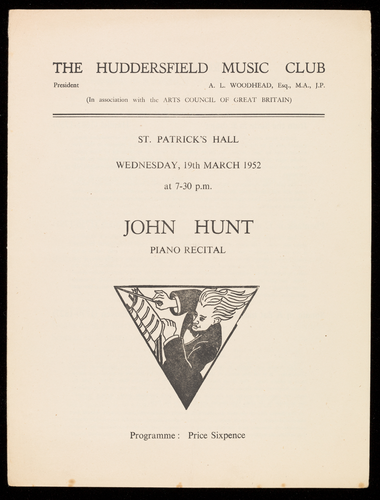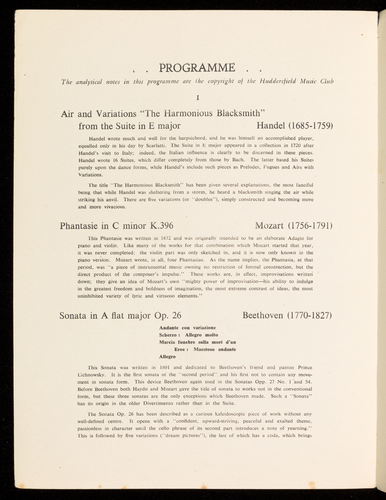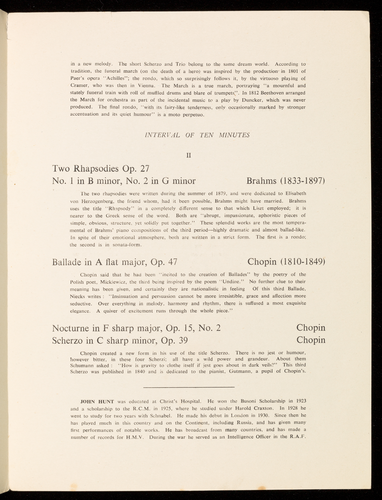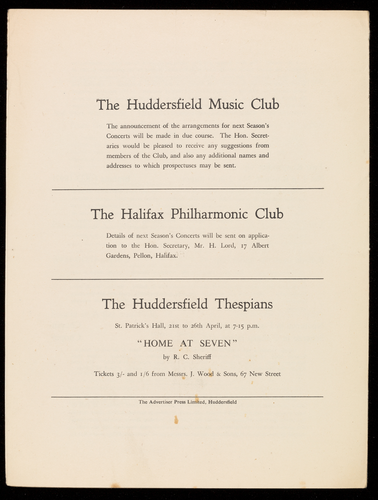Ocr'd Text:
The Huddersfield Music Club
(Founded in 1918 by Dr. Eaglefield Hull)
In association with the Arts Council of Great Britain
A SERIES OF SIX
CONCERTS
for the Thirty-fourth Season 1951-52
to be given in the
ST. PATRICK'S HALL, HUDDERSFIELD
on WEDNESDAY EVENINGS at 7-30 p.m.
Presents
President - A. L. WOODHEAD, Esq., M.A., J.P.
Active Vice-President - J. Stancliffe Ellis, Esq.
Honorary Vice-Presidents
Dr. Ralph Vaughan Williams, O.M. Dame Myra Hess, D.B.E.
Benjamin Britten
S. H. CROWTHER
E. GLENDINNING
Miss Z. E. HULL
P. L. MICHELSON
F. ROWCLIFFE
Miss A. SHAW
E. C. SHAW
Hon. Secretaries
Committee
Mrs. H. AINLEY
Mrs. ARNOLD
Mrs. BRANSOM
Mrs. S. H. CROWTHER
Miss K. EVANS
Mrs. E. FENNER
Mrs. D. HIRST
Mrs. A. E. HORSFALL
Mrs. A. E. HULL
Miss Z. E. HULL
Mrs. G. G. JARMAIN
1 Mrs. A. E. HULL, 48, New North Road. Tel. 1094
STANLEY G. WATSON, 342, New Hey Road. Tel. 1706
Hon. Treasurer-F. W. GADSBY, 222, Almondbury Bank. Tel. 2763.
I. SILVERWOOD
Mrs. I. SILVERWOOD
E. D. SPENCER
Mrs. P. SYKES
J. TROLLER
Mrs. S. G. WATSON
Ladies' Committee
Chairman-Mrs. P. SYKES
sm
Mrs. A. W. KAYE
Mrs. LIVINGSTONE
Mrs. J. LEE
Mrs. E. PARK
Mrs. M. M. SAYER
Miss A. SHAW
Mrs. I, SILVERWOOD
Mrs. E. D. SPENCER
Miss TOWNSEND
Miss E. WHITWAM
Hon. Secretary-Mrs. E. GLENDINNING
Hon. Treasurer-Mrs. S. G. WATSON
112
THE CLUB IS OPEN TO EVERYONE
Important-Please see back page
Ocr'd Text:
WEDNESDAY, OCTOBER 24th, 1951
Nina Milkina
PIANO RECITAL
Sonata in E minor, Op. 42
Variations in F major (K.54)
Sonata in A minor (K.310)
Mozart
Preludes, Mazurkas, Ballade in G minor ... Chopin
Works by Scriabin, Rachmaninoff and Prokofiev
...
...
...
...
...
WEDNESDAY, NOVEMBER 14th, 1951
....
Gerald Moore
A LECTURE-RECITAL
WEDNESDAY, DECEMBER 5th, 1951
...
...
THE ACCOMPANIST SPEAKS'
with HELGA MOTT (Soprano)
...
The Amadeus
String Quartet
Quartet in A major (K. 464) ...
Mozart
Hindemith
Quartet No. 6 ...
Quartet in B flat major, Op. 130... ... Beethoven
...
...
Haydn
... Mozart
...
...
...
99
Ocr'd Text:
WEDNESDAY, JANUARY 9th, 1952
Christmas Holiday Concert
William Pleeth and
Margaret Good
CELLO AND PIANO RECITAL
Sonata in A major, Op. 69
Sonata ...
..
Sonata
Sonata in E minor, Op. 38
..
7.
Beethoven
... Alan Rawsthorne
...
...
...
..... ... Debussy
.... Brahms
WEDNESDAY, FEBRUARY 13th, 1952
The Peter Gibbs
String Quartet
Quartet in E flat, Op. 9, No. 2...
Quartet in F, Op. 59, No. 1...
Quartet in F...
...
WEDNESDAY, MARCH 19th, 1952
.. Haydn
Beethoven
Ravel
John Hunt
PIANO RECITAL
Air and Variations from E major Suite ... Handel
Phantasy in C minor (K. 396) ...
Mozart
Sonata in A flat major, Op. 26 ... ... ... Beethoven
Works by Chopin and Brahms
...
mali
Ocr'd Text:
||||
bm
DIIS
|||
THE CLUB IS OPEN TO EVERYONE
boor
69
Subscriptions. A Member's subscription for the SEASON will
be 30/-. Season tickets may be obtained from either of the
Hon. Secretaries or from Messrs. J. Wood & Sons, Ltd., 67,
New Street; Messrs. Whitfield, Ltd., Ramsden Street; Messrs..
Kenneth Levell, Ltd., Market Street. Students' tickets will
not be issued this Season.
If you were a member last Season 2.
ticket(s) for the
coming season are enclosed herewith and it is requested that
the appropriate subscription be forwarded to the Hon.
Treasurer (Mr. F. W. Gadsby, 222, Almondbury Bank,
Huddersfield) before the date of the FIRST CONCERT..
Cheques should be made payable to "The Huddersfield Music
Club". In the event of any of the tickets not being required
this year, they should be returned to Mrs. Hull not later than
October 12th, after which date it will be assumed that they
will be retained and paid for.
If you were not a Member last Season will you please write as
early as possible to either of the Hon. Secretaries stating the
number of Season tickets required.
Members are requested to note that the Concerts will again be
given in
ST. PATRICK'S HALL
Members are recommended to occupy their seats not later than
7-15 p.m.
||||
PLEASE PASS THIS LEAFLET ON TO YOUR FRIENDS.
Ocr'd Text:
THE HUDDERSFIELD MUSIC CLUB
President
A. L. WOODHEAD, Esq., M.A., J.P.
(In association with the ARTS COUNCIL OF GREAT BRITAIN)
ST. PATRICK'S HALL
WEDNESDAY, 24th OCTOBER 1951
at 7-30 p.m.
NINA MILKINA
PIANO RECITAL
Programme Price Sixpence
Ocr'd Text:
PROGRAMME
The analytical notes in this programme are the copyright of the Huddersfield Music Club
I
Sonata in E minor, Op. 42
Presto
Adagio
Finale: Allegretto vivace
Variations in F major K.54
Sonata in D major, K.576
Allegro
Adagio
Allegretto
Two Preludes, Op. 28
In his book on Mozart, Einstein makes the interesting comment that Mozart conceived
a complete work as a whole; that with him a sonata, a quartet or a symphony is a work
not put together out of individual movements but that they are united by means of a
hidden logic; that there are no instances of his exchanging movements, as Beethoven did,
or of Mozart's taking a movement out of a work and sending it alone into the world. The
sole example of a "solitary movement" is the D major Minuet K.355, which Einstein
suggests might well have been the third movement of this, Mozart's last piano sonata.
It was written in 1787. That year Mozart had been in North Germany, hoping
apparently to find greater generosity from the Prussian Royal family than he had found
in Vienna. He wrote "I am composing six easy sonatas for Princess Friederike and six
quartets for the King". But only three quartets were completed and only this one sonata,
which was published posthumously. It cannot be described as easy, as it is essentially
contrapuntal, "full of duet-like oppositions" that recall Bach. "There is no thought of the
Princesses of Prussia in the finale, which combines the sweetness of piano sonorities with
the fine detail of a string trio, or in the deep longing and consolation of the Adagio"
(Einstein).
II
D flat major
D minor
Haydn (1732-1809)
Mozart (1756-1791)
Mozart
The 24 Preludes of Chopin-a Prelude in each key, major and minor-were published
in 1839. According to George Sand, they were written during their stay in Majorca; but
other evidence points to the fact the greater part of them were sketched or even written
before then, and then probably completed or revised there. Marlowe's line "Infinite beauty
in a little room" has been applied to them.
Op. 7 No. 3
Op. 7 No. 4
Chopin (1810-1849)
The Prelude in D flat major is one of the longest; its middle section changes to the
key of C sharp minor. Cortot compared the D flat section to a cradle song, the C sharp
section to a nightmare.
Op. 41 No. 1 I
Op. 51 No. 3
The Prelude in D minor is a complete contrast; "unbridled, maniacal fury; a terri-
fying piece, tremendous in its strength and passion".
Four Mazurkas
Chopin
Ocr'd Text:
Chopin wrote 51 Mazurkas, and they are perhaps the most characteristic of all his
works. In them the Polish temperament "marked by abrupt transitions from energy to
lassitude, gaiety to melancholy, exaltation to morbid depression, finds here its fullest and
most intimate expression." Some "offer fugitive glimpses of a single mood . . . . The
unexpected is always happening and, when it happens, it always seems natural and
inevitable, however wayward."
Not in all of them does the accent fall, as in the dance, on the third beat. Harmonic-
ally they are very daring. The majority are short; none are technically difficult but their
correct musical interpretation is one of the most difficult problems of Chopin's music.
Ballade in G minor, Op. 23
Chopin
This is the first of the four Ballades. It was written in 1836. It was inspired by the
poem "Konrad Wallrod" of the polish poet Adam Mickiewicz.
Interval of ten minutes
III
Three Studies Op. 8
D flat, No. 10
B flat minor, No. II
D sharp minor, No. 12
Scriabin (1872-1915)
Scriabin, pianist, composer and mystic, studied at the Moscow Conservatoire, where
he later taught; he won fame as a pianist and then retired to devote himself entirely to
composition. His early piano works show the influence of Chopin, and like Chopin, he
enlarged the scope of piano technique. His later works, both for piano and orchestra are
completely original, particularly in their harmonic aspect. His latest works are attempts
to express his philosophical ideas in the form of music combined with colour, movement
and even scent.
Prelude in G major, Op. 32, No. 5
Rachmaninoff (1873-1943)
Prokofiev (b. 1891)
Suggestion Diabolique
Frokofiev is one of the outstanding composers of modern Russia. Although he
studied in the older school of Rimsky-Korsakov and Liadov, his music has little relation
to their styles. He began composition at an early age. In 1923 he became associated with
Diaghilev for whom he wrote ballets (including Chout and Pas d'acier). He returned to
Russia in 1934, and although at first allowed contact with the western world, gradually
the fetters were tightened; in 1948 his name headed the list of Soviet composers who were
condemned by the Central Committee of the Communist Party of the U.S.S.R. Nabokov
observes that Prokofiev's music has changed little, and that it would be difficult to say
without knowledge whether a composition of his was a late or an early one. Prokofiev
wished to bring music back to pure sound, hence the simple harmonic texture, clear-cut
melody and squareness of rhythm. Often his music has a joking, even a sarcastic or ironic
flavour. The piano for him is purely an instrument of percussion, and his understanding
of it from that point of view is complete. "Suggestion diabolique" is one of his experi-
ments in polytonality
NINA MILKINA, the Russian-born pianist, began her musical career in London at
the age of seven, where she studied under Matthay and Craxton. She continued her studies
in Paris, where Rachmaninoff was greatly interested in her and predicted a great career
for her. At the same time she studied composition under Glazounov. Her first works were
written when she was only 11. Though young, Nina Milkina has a very wide concert
experience. Her interpretations of Mozart have won her special praise and the BBC
specially commissioned her to broadcast all the Mozart sonatas.
Ocr'd Text:
The Huddersfield Music Club
St. Patrick's Hall.
14th November 1951
GERALD MOORE
A Lecture-recital "The Accompanist speaks".
HELGA MOTT (Soprano)
5th December. The Amadeus String Quartet.
9th January. William Pleeth and Margaret Good (Piano and 'Cello)
13th February. The Peter Gibbs String Quartet.
19th March. John Hunt. Piano Recital.
Single tickets 6/6 and 2/6 (Gallery only) from Messrs. J. Wood & Sons and at the door.
26th October-
Wednesday evenings at 7-30
The Halifax Philharmonic Club
Lecture Hall of the Halifax Literary and Philosophical Society, Harrison Road.
Friday evenings at 7-30
Quintet in D major K.593
Quartet in C major Op. 76, No. 3
Quintet in G major Op. 111
With
THE AMADEUS STRING QUARTET
with CECIL ARONOWITZ (Viola)
7th December-
Mozart
Beethoven
Brahms
NINA MILKINA. Piano Recital
Sonata in A minor K.310
Sonatina
THE ADVERTISER PRESS LTD., HUDDERSFIELD
Mozart
Ravel
Bach
French Suite in B minor
Works by Chopin and Prokofiev
Single tickets 6/- at the door or from Mr. H. Lord, 17 Albert Gardens, Pellon, Halifax.
The Huddersfield Thespians
St. Patrick's Hall, 19th to 24th November, at 7-15 p.m.
CHANCE OF A LIFETIME (by George Taylor)
Tickets 3/- and 1/6 from Messrs. J. Wood & Sons, 67 New Street.
Ocr'd Text:
THE HUDDERSFIELD MUSIC CLUB
President
A. L. WOODHEAD, Esq., M.A., J.P.
(In association with the ARTS COUNCIL OF GREAT BRITAIN)
ST. PATRICK'S HALL
WEDNESDAY, 5th DECEMBER 1951
at 7-30 p.m.
The Amadeus String Quartet
NORBERT BRAININ (Violin)
SIEGMUND NISSEL (Violin)
PETER SCHIDLOF (Violin)
MARTIN LOVETT (Cello)
Programme Price Sixpence
Ocr'd Text:
PROGRAMME
The analytical notes in this programme are the copyright of the Huddersfield Music Club
I
Quartet in A major K.464
Allegro
Andante
Menuetto and Trio
Allegro non troppo
(Last performed in 1937 by the Roth String Quartet)
Mozart began to write the set of 6 quartets, which he dedicated to Haydn in 1773. For
nearly ten years this was a form of composition which Mozart had neglected; but during that period
he had deeply studied the art of counterpoint as well as the works of his immediate predecessors,
all of which must have led him towards this sudden outpouring of a wonderful series of chamber
music. It is difficult for us to understand how "advanced" these quartets sounded at that time.
They were subjected to violent criticism, and the "eccentricities" of their harmonies were even
described as "printer's errors".
This quartet is the fifth of the set and was written in Vienna in 1785. It is an example of
Mozart's new thematic style-the using of a theme in such a way that new ideas and inventions
constantly spring out of it, thus leading towards Beethoven's conception of a theme as something
from which the entire material inevitably grows. The first movement is contrapuntal, intimate in
style and contrapuntal treatment is freely used. The Andante is a set of six variations upon a fine
theme. The first variation follows the older Viennese model of decorative figuration, the later ones
seek rather for the underlying meaning of the theme. The sixth is built upon a dominant pedal.
The Finale was a particular favourite of Beethoven's; he copied it out with his own hand.
Quartet No. 6
Mozart (1756-1791)
II
Fast
Quiet, scherzando
Slow
Canon, moderately fast, gay
(First performance at these concerts)
Hindemith (b. 1895)
Paul Hindemith was born at Hanau of Silesian parents. In pre-Hitler days he was
considered to be Germany's leading composer, but, though "Aryan", he and his works were
labelled "degenerate" by the Nazis and were banned. (In Russia he, Schonberg and Stravinsky
are called the three arch-devils of "bourgeois decay".) Hindemith was educated at the Frankfort
Conservatoire, and has led an extraordinarily varied career. In early years he earned a living by
playing in cafes and dance-hails; later he became the leader of the Frankfort Opera Orchestra. In
1921 he founded the Amar-Hindemith String Quartet, in which he played the viola; he, in fact,
plays some dozen instruments and was the foremost viola player in Germany. In 1927 he began
to teach in the Berlin Hochschule, and in 1933 he went to Turkey to organise the musical life
there. He went to America in 1937 where he is now teaching in the Yale University School of
Music. He is an amazingly prolific and versatile composer, having written operas, ballets,
orchestral works, choral, chamber and piano music and songs. He has been called the greatest
living writer of fugues. "Sometimes he composes for children and humble amateurs, and sometimes
just for fun. His work is distinguished by clarity of thought, thorough workmanship, ease and
vitality." (Hutcheson). It has, too, a sense of humour not entirely German in character.
music is principally contrapuntal in texture and his harmony is influenced by atonality; his powers
of invention are fresh and unending.
His
This Quartet was written in 1945. The key signatures are discarded, but the impression is
that it begins and ends in a key which wavers between E flat major and minor. The short first
movement completely contrapuntal-is based upon two main themes; the first violin plays the
Ocr'd Text:
first at the opening; the second thenie, developed from a figure in the first, is played by the violin
solo (bar 36), the other instruments following it in canon. The second movement is soft and
delicate throughout with only one climax in it; the principal theme recurs throughout, given in
turn to each instrument and embellished with fresh figurations. A secondary theme has a curious
doubling in fifths. The third movement opens with a slow introduction. The main section is
strictly contrapuntal; it ends quietly in a form of B minor. The last movement opens with an
elaborate canon between the first violin and the viola. The basis of the whole movement is the
use of canon, sometimes incomplete, sometimes in augmentation, but always founded upon the main
subject. These canons are linked by connecting passages and much use is made of powerful pedal
basses. The whole movement is a striking example of modern contrapuntal writing.
INTERVAL OF TEN MINUTES
Quartet in B flat major Op. 130
III
Adagio ma non troppo-Allegro
Presto
Beethoven (1770-1827)
Andante con moto ma non troppo
Alla danza tedesca: Allegro assai
Cavatina: Adagio molto espressivo
Finale: Allegro
(Last performed in 1948 by the New Italian String Quartet)
The years 1824-26 saw the appearance of Beethoven's last string quartets. Perhaps Op. 130,
though written under most distressing conditions of illness, anxiety and complete deafness, is the
greatest of them all. It has six movements instead of the traditional four. Thus Beethoven has,
as it were, returned to the older form of the Suite, breaking away from the classical quartet in
order to express himself more fully, just as in the late piano sonatas, he abandoned regular sonata
form to return to the free fantasia.
The opening movement makes great use of the Adagio introduction in combination with the
first subject; the second subject is of wonderful beauty. Some listeners have compared the move-
ment to a struggle between two instincts-one gently pleading, the other inexorably violent-in
the same individual. The Presto (a Scherzo) is humorous and fanciful; the subtle Andante, half
playful, half tender. A German country dance provides the rhythm of the fourth movement. The
Cavatina is the emotional climax for the work and is one of the most supreme things in all music,
full of the most noble expressiveness and an almost unearthly serenity. Of it Beethoven said to
Holz, "Never did music of mine make so deep an impression on me, even the remembrance of
the emotions it aroused always cost me a tear". This serenity is interrupted by a strange episode,
marked by Beethoven "beklemmt"; this is translated by Newman as "with a tightening at the
heart".
Beethoven had intended the "Grosse Fuge" Op. 133, the fugue which is the crown of the
whole work and in which the essence of it is to be found, to form the finale of the quartet. But
he yielded to the solicitations of his friends and publishers and wrote-his last completed work-a
new finale, one so exuberant that it is difficult to believe it to be the work of a man already
stricken with a fatal illness. Specht calls this movement a "defiant Dance of Death".
THE AMADEUS STRING QUARTET was formed as a professional ensemble in 1947 after
several years of playing together during their years of study. Following the success of their first
London appearance in 1948, they have been in great demand by Chamber Music Societies through-
out the country and have toured extensively. They are frequent broadcasters in the Third
Programme and Home Services of the B.B.C.
Each member of the Quartet studied under Max Rostal, and the leader, Brainin, was the
winner of the Carl Flesch prize in the 1946 competition. All the members of the ensemble are
under 30 years of age, and it is interesting to note that three of them are Viennese in origin,
having been in this country since their early 'teens.
Ocr'd Text:
The Huddersfield Music Club
St. Patrick's Hall.
9th January 1952
WILLIAM PLEETH and MARGARET GOOD
Cello and Piano Recital
Sonata in A major Op. 69
Sonata
Wednesday evenings at 7-30.
Beethoven
Alan Rawsthorne
Sonata
Sonata in E minor Op. 38
13th February. The Peter Gibbs String Quartet.
19th March. John Hunt. Piano Recital.
Single tickets 6/6 and 2/6 (Gallery only) from Messrs. J. Wood and Sons and at the door.
Debussy
Brahms
The Halifax Philharmonic Club
Lecture Hall of the Halifax Literary and Philosophical Society, Harrison Road.
Friday evenings at 7-30
7th December-
Piano Recital
Mozart
Ravel
Bach
NINA MILKINA.
Sonata in A minor K.310
Sonatina
French Suite in B minor
Works by Chopin and Prokofiev
Single tickets 6/- at the door or from Mr. H. Lord, 17 Albert Gardens, Pellon, Halifax.
The Advertiser Press Limited, Huddersfield
The Huddersfield Thespians
St. Patrick's Hall, 21st to 26th January, at 7-15 p.m.
An adaptation of
"WASHINGTON SQUARE" (by Henry James)
Tickets 3/- and 1/6 from Messrs. J. Wood & Sons, 67 New Street.
Ocr'd Text:
THE HUDDERSFIELD MUSIC CLUB
A. L. WOODHEAD, Esq., M.A., J.P.
President
(In association with the ARTS COUNCIL OF GREAT BRITAIN)
ST. PATRICK'S HALL
WEDNESDAY, 9th JANUARY 1952
at 7-30 p.m.
William Pleeth and Margaret Good
CELLO AND PIANO RECITAL
EV
Programme Price Sixpence
Ocr'd Text:
PROGRAMME
The analytical notes in this programme are the copyright of the Huddersfield Music Club
Sonata in A major, Op. 69
I
Sonata
Allegro ma non tanto
Scherzo. Molto allegro
Adagio cantabile - Allegro vivace
(Last performed in 1930 by Gaspar Cassado)
Beethoven wrote five sonatas for cello and piano between 1796 and 1815. The Sonata in
A major was the third and was written in 1808. "With Beethoven came the first sonatas of true
musical importance for piano and cello, and it is interesting to see with what speed and freedom
he developed the possibilities of the string instrument, using it in all registers even in the first
sonata" (Ivor James). But it must be remembered that though the cello has remained practically
unaltered since that time, the piano has become a very different and more powerful instrument.
Bekker considers that Beethoven's cello sonatas are, on the whole, more successful than the violin
ones; "they show a wider range of thought and richer variety of form. The cello is better
adapted as a solo instrument for chamber music duets than the violin; its noble tenor tone and
virile, earnest yet adaptable and sympathetic character surpass for this purpose the coquetry and
bravura of the violin and substitute simple cantabile for firework effects."
Beethoven (1770-1827)
The first movement, in sonata form, gives the impression of being written in three parts
throughout. The cello opens solo with the first subject; the second subject, like a canon, is
given by the piano. The charming Scherzo, with its ascending syncopated rhythm, forms,
contrary to custom, the second movement; its Trio recalls that of the A major Symphony. The
only hint of slow movement lies in the short introduction to the last movement.
II
Alan Rawsthorne (b. 1905)
Adagio - Allegro appassionato
Adagio
Allegro molto
(First performance at these concerts)
Alan Rawsthorne was born at Haslingden, Lancashire. He went to the Royal Manchester
College of Music in 1926 where he studied piano, cello and composition. He remained there
for four years and then went abroad to study, including piano under Egon Petri. He later
became a teacher at Dartington Hall and provided music there for the School of Dance Mime.
His first international fame was won in 1938 by the performance of his Theme and Variations
for two violins at the London Festival of the International Society for Contemporary Music.
His pre-war works include symphonic studies and an excellent piano concerto. Since the war
many important compositions have come from him. These include a Quartet for Clarinet and
Strings, a Violin Concerto, a Cello Sonata, a Concerto for string orchestra, a Symphony as well
as smaller works. His latest work is a second Piano Concerto, commissioned for the Festival of
Britain. Rawsthorne's reputation is now established as one of the leading composers of the
country.
The Cello Sonata, written in 1949, is the latest, and in the opinion of many, the finest of
his chamber music works. The expressive Adagio leads into an Allegro appassionato. The slow
movement (Adagio) runs without a break into a vigorous Allegro molto. This last movement
is interrupted, from time to time, by short and slow passages for cello solo and also by a more
extended reference to the slow movement.
Ocr'd Text:
Sonata in D minor
III
Debussy (1862-1918)
Prologue
Serenade
Finale
(Last performed in 1949 by Pierre Fournier and Ernest Lush)
Debussy wrote one sonata only for cello and piano. In his last years he had planned to
write "Six Sonates pour divers instruments par Claude Debussy, musicien francais". Only three
of the six were completed: the sonata for cello and piano (1915), for flute, viola and harp (1916)
and for violin and piano (1916-17).
The cello sonata was suggested by Italian comedy and was to have been called "Pierrot fache
avec la lune". The short first movement is declamatory in style. The second has a kind of
humour; the cello imitates the mandoline. The third movement, which is linked to the second,
has a folk-song flavour.
INTERVAL OF TEN MINUTES
Sonata in E minor, Op. 38
Allegro
Allegro quasi menuetto
Allegro non troppo
(Last performed in 1938 by Antonia Butler and George Reeves)
Brahms (1833-1898)
Brahms in the course of his whole career wrote only two sonatas for cello and piano. The
first two movements of this, the earlier work, together with an Adagio movement which was
discarded, was written in 1862. The present Finale dates from 1865. Geiringer considers this
sonata, in spite of its prevailing tenderness, to be in a certain sense an act of homage to
Bach. He bases this theory on the fact that the main theme of the first movement
closely related to the "Contrapunctus III" from the "Art of Fugue", while the subject of the
Finale is astonishingly like the "Contrapunctus XIII" from the same work.
This sonata is dark in colouring; throughout, the cello hardly ever rises above its tenor
register and full use is made of the noble bass that it can give to the piano. "The first
movement marches like 'solemn tragedy in sceptred pall' until the quiet major end of its
indignant second subject is, in the recapitulation, expanded into a pathetic coda in which the
movement expires in peace." (Tovey). The development is very broad. There is no slow
movement. Instead there is a graceful Minuet in A minor. It opens with a short motto-like
group of four notes, which plays an important part throughout, especially in the contrasting Trio
in the key of F sharp minor. The third movement, again in E minor, is a strict fugue with a
free middle section and a da capo. The piano opens with the running triplet subject in the
bass; it is answered by the cello entry, and the third voice is heard in the treble of the piano.
The brilliance of the piano part is so great that the cello can scarcely hold its own against it.
An increasingly brilliant coda makes a fine conclusion to a work of undoubted power and interest.
WILLIAM PLEETH won a scholarship to the Leipzig Conservatoire and studied there under
Klengel. He returned to England in 1933 when he made his first broadcast. He has a Trio with
Rubbra, the composer, with whom he served in the army, and with Erich Gruenberg. He has
played at all the leading concerts. In 1948 he was appointed Professor of Chamber Music at
the Guildhall School of Music and later became Professor of cello there. He married Margaret
Good in 1944.
MARGARET GOOD won a scholarship to the R.A.M. at the age of sixteen and made her
first broadcast in 1930 while a student. Since then she has broadcast regularly and has appeared
at the leading concerts. She is specially interested in modern music and has given many first
performances of new music, some of which has been specially written for her. William Pleeth
and Margaret Good gave their first sonata recital in 1938 and have played together frequently
since that date. Many British composers have written works specially for them including Rubbra,
who dedicated his Cello Sonata to them.
Ocr'd Text:
St. Patrick's Hall.
7-10-0
47 +3 +66
20
12
DRO
120.0
$6-10
10-0
3.1 3
13th February, 1952.
120 THE PETER GIBBS STRING
Quartet in E flat, Op. 9, No. 2
Quartet in F, Op. 59, No. 1
Quartet in F
19th March. John Hunt. Piano Recital.
Single tickets 6/6 and 2/6 (Gallery only) from Messrs. J. Wood and Sons and at the door.
The Huddersfield Music Club
10/22 (130
3
6.3.6
QUARTET
Haydn
Beethoven
Ravel
The Halifax Philharmonic Club
Lecture Hall of the Halifax Literary and Philosophical Society, Harrison Road.
Friday evenings at 7-30
18th January, 1952
THE ALEPH STRING QUARTET
66
Wednesday evenings at 7-30
£9-0
87. 2/
Haydh
Smetana
Mendelssohn
Mozart
The Huddersfield Thespians
St. Patrick's Hall, 21st to 26th January, at 7-15 p.m.
Quartet in F major, Op. 3 No. 5
Quartet in E minor, Op. 116
Capriccio and Fugue
Quartet in B flat major, K.458
Single tickets 6/- at the door or from Mr. H. Lord, 17 Albert Gardens, Pellon, Halifax.
mil) M (1
2013!
THE HEIRESS
An adaptation of "Washington Square" (by Henry James)
Tickets 3/- and 1/6 from Messrs. J. Wood & Sons, 67 New Street.
The Advertiser Press Limited, Huddersfield
ola
6
seahor
~H
6
am
mimi
Ocr'd Text:
THE HUDDERSFIELD MUSIC CLUB
President
A. L. WOODHEAD, Esq., M.A., J.P.
(In association with the ARTS COUNCIL OF GREAT BRITAIN)
ST. PATRICK'S HALL
WEDNESDAY, 13th FEBRUARY 1952
at 7-30 p.m.
The Peter Gibbs String Quartet
PETER GIBBS (Violin)
KELLY ISAACS (Violin)
PATRICK IRELAND (Viola)
BRUNO SCHRECKER (Cello)
Programme Price Sixpence
Ocr'd Text:
PROGRAMME
The analytical notes in this programme are the copyright of the Huddersfield Music Club
Quartet in E flat, Op. 9 No. 2
I
Moderato
Minuet and Trio
Adagio
Allegretto
(First time at these Concerts)
Cantabile
Haydn (1732-1809)
The set of six quartets Op. 9 were written in 1769 while Haydn was in the service of Prince
Esterhazy. Haydn had written three other sets of six each in 1755. Of these Opp. 1 and 2
belong closely to the form of the Suite; they all have, with one exception, five movements includ-
ing two minuets. The quartets of Op. 3 are drawing closer to the classical model, with their 2,
3 or 4 movements; but it is not till the quartets of Op. 9 that the true form emerges. A world
of difference lies between these two opuses, as well as a mass of compositions, which includes the
first forty symphonies. Haydn himself requested his publisher, Artaria, to put the quartets Op. 9
forward as his first and to ignore the earlier ones.
A notable feature of these quartets is the brilliant character of the first violin part, with its
elaborate runs and its wide range. The explaration lies in the fact that Tomasini, the first violin
of the Prince's orchestra, was unusually gifted technically.
As in four of the quartets of this set, the first movement of No. 2 is marked at an unusually
slow tempo. This gives scope to the first violin to indulge in much graceful ornamentation. The
Minuet has one of Haydn's most charming melodies; he used it later as the theme for a litte set
of piano variations The slow movement is really an arioso; in it Geiringer finds "particularly
in the Adagio which precedes the cantabile, in which the tension of an impassioned introduction is
resolved into a melody of profound sadness" the foreshadowing of Haydn's Storm and Stress
period. Tovey points out that this movement gives another proof of the influence C. P. E. Bach
had on Haydn; for its form, in which the first section instead of being marked by a "repeat" is
written out in full in order that the ornaments of the melody may be varied, was C. P. E. Bach's
special invention and was highly prized by him. The short Finale is full of delightful rhymthmical
effects.
II
Quartet in F major, Op. 59, No. 1
Allegro
Allegretto vivace e sempre scherzando
Adagio molto e mesto
Theme russe: Allegro
(Last performed in 1931 by the Lener String Quartet)
Beethoven (1770-1827)
This is the first of the three quartets written in 1806; they were commissioned by Prince
Rasumovsky and dedicated to him. The Prince was the Russian ambassador to the Court at
Vienna, where his palace became the centre of the artistic life of the city. He was himself a player
of stringed instruments and had been initiated into the mysteries of quartet style by Haydn himself.
He engaged Schuppanzigh and his three colleagues for life as his private Quartet; they became the
acknowledged interpreters of Beethoven's quartets and their services were placed at his disposal.
The ruin of the Prince's palace by fire ended this fruitful association.
Beethoven had written no quartets since the six of Op. 18 in 1800. The Rasumovksy quartets
represent an enormous advance both technically and emotionally. Bekker considers that all three
are the embodiments of a single poetic idea, variously presented. Exterior conflicts are first
Ocr'd Text:
portrayed, then interior problems. . triumph is the underlying motive. This central idea of triumph
gives rise to monumental style of the Rasumovsky quartets, and the result is a series of works of a
majesty and expressive power such as no one before Beethoven had dreamed of obtaining from
four string instruments".
All four movements of this quartet are written in first-movement (sonata) form-a most
unusual scheme. The Allegro opens with a broad and noble theme for the cello which is continued
by the violin to a great height. A bridge passage leads to the second subject (first violin). The
development contains a remarkable passage for strings in unison and a fugal portion founded upon
part of the second subject. The Allegretto serves as a Scherzo; rhymthic figures persist throughout,
interspersed with short legato passages. The Adagio, "that mournful, sublime, and yet gentle
lament", is a true Beethoven Adagio; the cello, in a high register, plays an important part. The
Adagio is connected with the last movement by an elaborate cadenza for the violin. The Finale,
which is almost orchestral in style, is founded upon a Russian folk-song theme.
Quartet in F major
INTERVAL OF TEN MINUTES
III
Ravel (1875-1937)
Allegro moderato
Assez vif, tres rhythme
Tres lent
Vif et agite
(Last performed in 1945 by the Calvet String Quartet)
Although Ravel is one of the most important modern French composers, he was not of purely
French origin; his father was French-Swiss while his mother was Basque. It is from the latter that
he inherits so many of the southern traits to be found in his music-the feeling for light and
colour and the complex rhythms. But the virtues of the French culture are added to these-
craftsmanship, restraint, fastidiousness, intelligence, wit and unerring taste and balance. His output
is relatively not large; and he only wrote one work for string quartet.
This quartet, written in 1902-03, is dedicated to his master, Gabriel Faure; and its first move-
ment, in sonata form, opens in almost a Faure-like manner. It soon develops its own character
and style with many changes of colour and tempo. The second movement is a really original
Scherzo, with a pizzicato opening and a contrasting section of much melodic charm. The slow
movement is complex in style, with fleeting references to the first movement; it ends with a
wonderful raising of all four instruments to their highest registers. The final movement, in 5/8
time, is by turn stormy and calın; both its main subjects have references to material in the first
movement- a method of thematic development which is to be found in much of Ravel's music.
PETER GIBBS won a scholarship to the Trinity College of Music at the age of 12; before the
war he was reading for a Modern Languages degree at Oxford. During the war he served as a
fighter pilot and returned to Oxford to read for his Mus. Bac. degree. Together with Patrick
Ireland he formed the Gibbs String Quartet, and on the advice of Sydney Griller, it became a
professional combination.
KELLY ISAACS studied the violin from the age of 9. He won a scholarship to the R.A.M.
but owing to the war, he was unable to take it up. Immediately before the war, he was
studying for his B.Sc. degree at Rangoon University; he escaped to India where he led the
orchestra of the Maharajah of Patiala. He came to England in 1946 to take up his scholarship at
the R.A.M.
PATRICK IRELAND was educated at Wellington and Oxford. He was studying at the
R.C.M. at the outbreak of war. He became a pilot of Coastal Command. After the war he
returned to Oxford to study for the Mus. Bac. degree.
BRUNO SCHRECKER was born at Frankfurt and came to England in 1933. He won a
scholarship at the R.C.M. where he studied with Ivor James. He later studied with Piet Lentz in
Amsterdam.
Ocr'd Text:
The Huddersfield Music Club
St. Patrick's Hall.
19th March
JOHN HUNT
Piano Recital
Air and Variations from E major Suite
Phantasy in C minor K.396
Sonata in A flat major, Op. 26
Wednesday evenings at 7-30
and works by Chopin and Brahms.
Single tickets 6/6 and 2/6 (Gallery only) from Messrs. J. Wood and Sons and at the door.
Handel
Mozart
Beethoven
The Halifax Philharmonic Club
Lecture Hall of the Halifax and Philosophical Society, Harrison Road.
Friday evenings at 7-30
Sonata in G minor
Sonata in G major
Sonata
22nd February
ANTONIA BUTLER and NORMAN GREENWOOD
Cello and Piano Recital
Handel
Bach
The Advertiser Press Limited, Huddersfield
Moeran
Beethoven
Brahms
Seven Variations on a Theme by Mozart
Sonata in E minor, Op. 38
Single tickets 6/- at the door or from Mr. H. Lord, 17 Albert Gardens, Pellon, Halifax
The Huddersfield Thespians
St. Patrick's Hall, 3rd to 8th March, at 7-15 p.m.
"THE LADY'S NOT FOR BURNING "
by Christopher Fry
Tickets 3/- and 1/6 from Messrs. J. Wood & Sons, 67 New Street.
Ocr'd Text:
THE HUDDERSFIELD MUSIC CLUB
A. L. WOODHEAD, Esq., M.A., J.P.
President
(In association with the ARTS COUNCIL OF GREAT BRITAIN)
ST. PATRICK'S HALL
WEDNESDAY, 19th MARCH 1952
at 7-30 p.m.
JOHN HUNT
PIANO RECITAL
Programme Price Sixpence
Ocr'd Text:
PROGRAMME.
The analytical notes in this programme are the copyright of the Huddersfield Music Club
I
Air and Variations "The Harmonious Blacksmith"
from the Suite in E major
Handel (1685-1759)
Handel wrote much and well for the harpsichord, and he was himself an accomplished player,
equalled only in his day by Scarlatti. The Suite in E major appeared in a collection in 1720 after
Handel's visit to Italy; indeed, the Italian influence is clearly to be discerned in these pieces.
Handel wrote 16 Suites, which differ completely from those by Bach. The latter based his Suites
purely upon the dance forms, while Handel's include such pieces as Preludes, Fugues and Airs with
Variations.
The title "The Harmonious Blacksmith" has been given several explanations, the most fanciful
being that while Handel was sheltering from a storm, he heard a blacksmith singing the air while
striking his anvil. There are five variations (or "doubles"), simply constructed and becoming more
and more vivacious.
Phantasie in C minor K.396
Mozart (1756-1791)
This Phantasie was written in 1872 and was originally intended to be an elaborate Adagio for
piano and violin. Like many of the works for that combination which Mozart started that year,
it was never completed; the violin part was only sketched in, and it is now only known in the
piano version. Mozart wrote, in all, four Phantasias. As the name implies, the Phantasia, at that
period, was "a piece of instrumental music owning no restriction of formal construction, but the
direct product of the composer's impulse." These works are, in effect, improvisations written
down; they give an idea of Mozart's own "mighty power of improvisation-his ability to indulge
in the greatest freedom and boldness of imagination, the most extreme contrast of ideas, the most
uninhibited variety of lyric and virtuoso elements."
Sonata in A flat major Op. 26
Andante con variazione
Scherzo : Allegro molto
Marcia funebre sulla mort d'un
Eroe : Maestoso andante
Beethoven (1770-1827)
Allegro
This Sonata was written in 1801 and dedicated to Beethoven's friend and patron Prince
Lichnowsky. It is the first sonata of the "second period" and his first not to contain any move-
ment in sonata form. This device Beethoven again used in the Sonatas Opp. 27 No. 1 and 54.
Before Beethoven both Haydn and Mozart gave the title of sonata to works not in the conventional
form, but these three sonatas are the only exceptions which Beethoven made. Such a "Sonata"
has its origin in the older Divertimento rather than in the Suite.
The Sonata Op. 26 has been described as a curious kaleidoscopic piece of work without any
well-defined centre. It opens with a "confident, upward-striving, peaceful and exalted theme,
passionless in character until the cello phrase of its second part introduces a note of yearning."
This is followed by five variations ("dream pictures"), the last of which has a coda, which brings
Ocr'd Text:
in a new melody. The short Scherzo and Trio belong to the same dream world. According to
tradition, the funeral march (on the death of a hero) was inspired by the production in 1801 of
Paer's opera "Achilles"; the rondo, which so surprisingly follows it, by the virtuoso playing of
Cramer, who was then in Vienna. The March is a true march, portraying "a mournful and
stately funeral train with roll of muffled drums and blare of trumpets". In 1812 Beethoven arranged
the March for orchestra as part of the incidental music to a play by Duncker, which was never
produced. The final rondo, "with its fairy-like tenderness, only occasionally marked by stronger
accentuation and its quiet humour" is a moto perpetuo.
INTERVAL OF TEN MINUTES
II
Two Rhapsodies Op. 27
No. 1 in B minor, No. 2 in G minor
Brahms (1833-1897)
The two rhapsodies were written during the summer of 1879, and were dedicated to Elisabeth
von Herzogenberg, the friend whom, had it been possible, Brahms might have married. Brahms
uses the title "Rhapsody" in a completely different sense to that which Liszt employed; it is
nearer to the Greek sense of the word. Both are "abrupt, impassionate, aphoristic pieces of
simple, obvious, structure, yet solidly put together." These splendid works are the most tempera-
mental of Brahms' piano compositions of the third period-highly dramatic and almost ballad-like.
In spite of their emotional atmosphere, both are written in a strict form. The first is a rondo;
the second is in sonata-form.
Ballade in A flat major, Op. 47
Chopin (1810-1849)
Chopin said that he had been "incited to the creation of Ballades" by the poetry of the
Polish poet, Mickiewicz, the third being inspired by the poem "Undine." No further clue to their
meaning has been given, and certainly they are nationalistic in feeling Of this third Ballade,
Niecks writes: "Insinuation and persuasion cannot be more irresistible, grace and affection more
seductive. Over everything in melody, harmony and rhythm, there is suffused a most exquisite
elegance. A quiver of excitement runs through the whole piece."
Nocturne in F sharp major, Op. 15, No. 2
Scherzo in C sharp minor, Op. 39
Chopin
Chopin
Chopin created a new form in his use of the title Scherzo. There is no jest or humour,
however bitter, in these four Scherzi; all have a wild power and grandeur. About them
Schumann asked: "How is gravity to clothe itself if jest goes about in dark veils?" This third
Scherzo was published in 1840 and is dedicated to the pianist, Gutmann, a pupil of Chopin's.
JOHN HUNT was educated at Christ's Hospital. He won the Busoni Scholarship in 1923
and a scholarship to the R.C.M. in 1925, where he studied under Harold Craxton. In 1928 he
went to study for two years with Schnabel. He made his debut in London in 1930. Since then he
has played much in this country and on the Continent, including Russia, and has given many
first performances of notable works. He has broadcast from many countries, and has made a
number of records for H.M.V. During the war he served as an Intelligence Officer in the R.A.F.
Ocr'd Text:
The Huddersfield Music Club
The announcement of the arrangements for next Season's
Concerts will be made in due course. The Hon. Secret-
aries would be pleased to receive any suggestions from
members of the Club, and also any additional names and
addresses to which prospectuses may be sent.
The Halifax Philharmonic Club
Details of next Season's Concerts will be sent on applica-
tion to the Hon. Secretary, Mr. H. Lord, 17 Albert
Gardens, Pellon, Halifax.
The Huddersfield Thespians
St. Patrick's Hall, 21st to 26th April, at 7-15 p.m.
"HOME AT SEVEN"
by R. C. Sheriff
Tickets 3/- and 1/6 from Messrs. J. Wood & Sons, 67 New Street
The Advertiser Press Limited, Huddersfield






























 loading...
loading...

